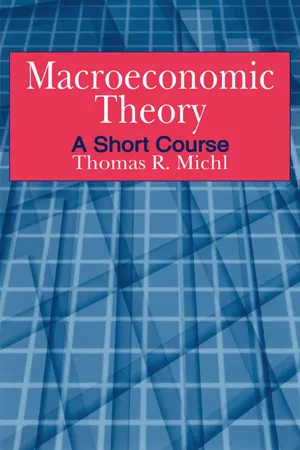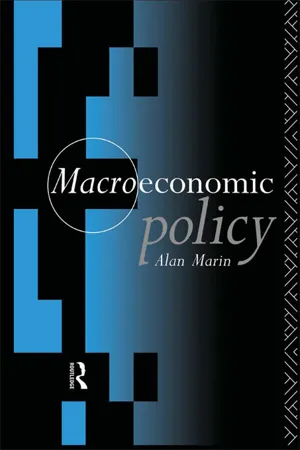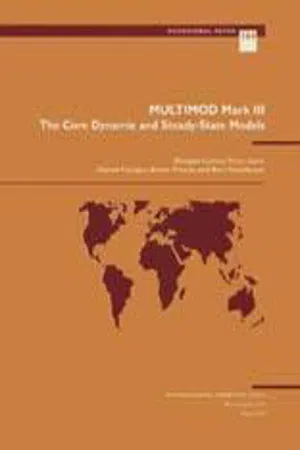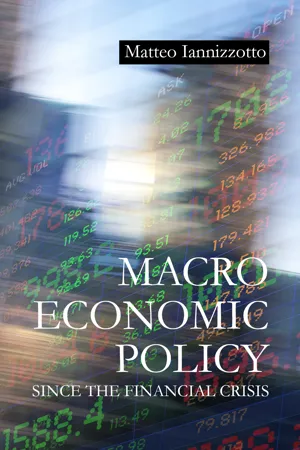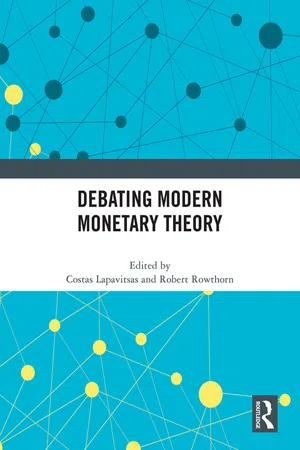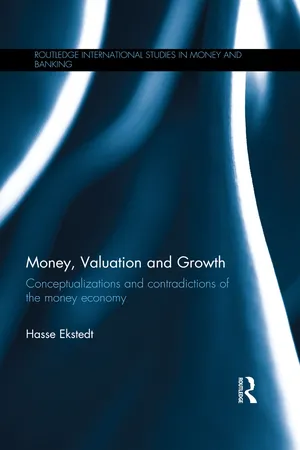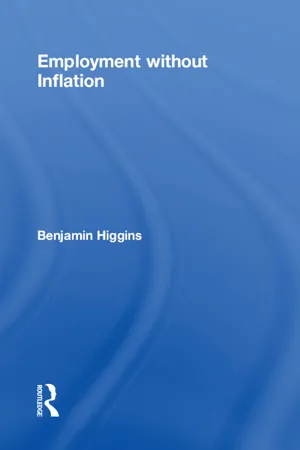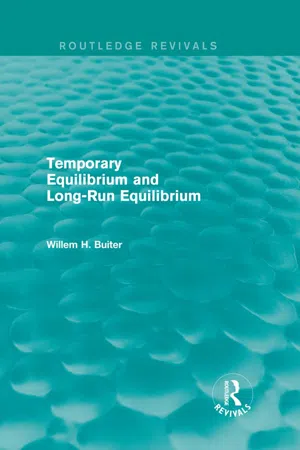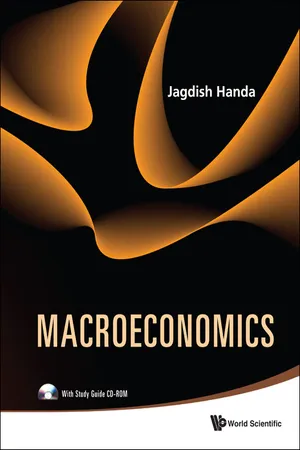Economics
Long-Run Phillips Curve
The Long-Run Phillips Curve represents the relationship between inflation and unemployment in the long term. It suggests that in the long run, there is no trade-off between inflation and unemployment, and the economy will settle at the natural rate of unemployment regardless of the inflation rate. This concept is important for understanding the dynamics of inflation and unemployment over extended periods.
Written by Perlego with AI-assistance
Related key terms
Related key terms
1 of 4
Related key terms
1 of 3
11 Key excerpts on "Long-Run Phillips Curve"
- eBook - ePub
Macroeconomic Theory: A Short Course
A Short Course
- Thomas R. Michl(Author)
- 2015(Publication Date)
- Routledge(Publisher)
overshoot its long-run equilibrium repeatedly. Overshooting is best understood through a physical analogy with a pendulum. If you start a pendulum away from its rest point, it will descend to the rest point and keep on going, thus overshooting its long-run equilibrium (the rest point). In the Phillips curve model, the lagged response of inflation expectations to actual inflation generates overshooting.10.6 Long-run equilibrium
When we use the expression “long run” in economics, it means that the system is fully adjusted along some dimensions. In the Phillips curve model, the long-run is defined by attainment of the natural rate of unemployment and by equality between the inflation rate and the expected inflation rate. The term long-run is also used in other contexts in economics to describe an equilibrium in which the capital stock has had time to adjust fully to economic forces. Some writers have begun using the term “medium run” to describe the former state, devoting long-run to the latter.The long-run equilibrium in the Phillips curve occurs when the inflation and unemployment rates have converged on stable, constant values. We can easily solve for those values by substituting zeroes into the Phillips curve model in difference form. The solution isΔ u = 0Δ π = 0g Y= 0π =g mu =u nThis is a long-run equilibrium because the system is fully adjusted in its two important dimensions. The inflation rate has settled down to the long-run value that generates no changes in the unemployment rate. The unemployment rate has settled down to the natural rate, at which the expected inflation rate equals the actual inflation rate. Thus, there are no further shifts in the Phillips curve caused by revisions in inflation expectations, or further changes in the unemployment rate, caused by changes in the real money supply. This characterization of the long run will become clearer in the next section.The long-run inflation rate is equal to the growth rate of the money supply. This illustrates the quantity theory of money (or if you prefer, the quantity of money theory of prices). Figure 10.4 shows that different choices by the central bank of monetary growth rates have no effect on the long-run unemployment rate, which remains the natural rate of unemployment. When money growth has no real effects on the economy—when it only affects the inflation rate—money is said to be superneutral The vertical Long-Run Phillips Curve shown in Figure 10.4 illustrates the superneutrality of money. One implication of superneutrality is that any policy effort to lower the unemployment rate below its natural rate (i.e., force the economy to operate to the left of the Long-Run Phillips Curve) can only be effective if the inflation rate is constantly rising. This is called the accelerationist hypothesis - eBook - ePub
Inflation Dynamic
Global Positive Economic Analysis
- Weshah Razzak(Author)
- 2023(Publication Date)
- Routledge(Publisher)
a unique non-accelerated inflation rate that is consistent with unemployment. The fact, according to Friedman and most non-Keynesian economists, is that there is no such unique inflation rate. In the long run, the natural rate of unemployment rate is consistent with an infinite number of inflation rates. This precisely means the Long-Run Phillips Curve is vertical.The Phillips curve specification took several forms in the literature. Keeping with the Keynesian story, there are two Keynesian specifications. There is the original Phillips curve specification linking the level of inflation to the unemployment rate (no expectations) and the New Keynesian typical specification linking the change in inflation to unemployment. Let the Phillips curve be:(8.1)π t= α + βπ t e+U t,whereπ tis the CPI inflation rate,U tis the unemployment rate, the superscript e on top of the inflation rate denotes the expectation operator, and α β are parameters to be estimated. The theory of expectations formation turned out to be crucial and complicates the Phillips curve policy implications. We will provide detail empirical examination in the next chapter. The coefficientβshould be indifferent from unity, if Phelps’s Accelerationist hypothesis is true; therefore, the unemployment rate is −α , which is consistent with a vertical Long-Run Phillips Curve when inflation is equal to expected inflation. Therefore, this value of U satisfies the NAIRU and the natural rate too. All other values of U either represent the short-term equilibrium or some stochastic component of the NAIRU. I am unaware of new surveys, but (Turnovsky, 1974 ) is a good “old” summary of all the empirical studies in the past. The majority of those old studies used time series data for different countries and covering different spans of time. Most estimates of β in Turnovsky were less than 1. There are important ramifications in caseβ < 1 - eBook - ePub
- Alan Marin(Author)
- 2005(Publication Date)
- Routledge(Publisher)
any constant (as distinct from changing) rate of inflation. For example, if we continue our assumption about mark-up pricing, the natural rate of unemployment is where any desired increase in real wages is equal to productivity change. Thus, at the natural rate, if there is an x% price inflation expected, x% will be added to a wage change that would otherwise have led to no price change. So money wages rise by x% more than the no-change amount, leading to an x% rise in prices. But this means that the actual price rise equals that expected. Expectations turn out to be correct, and so will not be changed any further. Thus there is a steady x% inflation.Figure 4.8 The vertical Philips CurveThis can be called a ‘long-run equilibrium’: it is an equilibrium in the sense that inflation is constant (even though the price level is not) and like all equilibria (see Chapter 2 ) expectations are fulfilled. Since this argument holds for any value of x, all of the points in Fig. 4.8 are possible long-run equilibrium positions, and joining them up we have a Vertical Long-Run Phillips Curve’.For those who are happy with equations, the same argument, that there is only a single rate of unemployment which gives equilibrium, can also be shown even more directly by using equation (4.6). For simplicity take the casewhere there is no productivity change, so that Then:But if , and for equilibrium, we will have equilibrium if, and only if, f(U)=0.40 The level of unemployment, which gives f(U)=0, is the natural rate,U*. Furthermore, if we have f(U)=0 so then equation (4.7) reduces to which is compatible with any value ofAlthough the name ‘vertical Phillips Curve’ is commonly used, it is in a sense misleading. The policy implication of the Phillips Curve was that of a trade-off between inflation and unemployment. The policy implication of the Friedman critique was that there is no exploitable trade-off. As the theory came to be more widely accepted in the 1970s, the view spread among policy-makers that, to quote the UK Labour Prime Minister James Callaghan in 1976, ‘It used to be thought that we could spend our way out of unemployment… that option is no longer available’. - Hamid Faruqee, Douglas Laxton, Bart Turtelboom, Peter Isard, and Eswar Prasad(Authors)
- 1998(Publication Date)
- INTERNATIONAL MONETARY FUND(Publisher)
If monetary policy becomes highly inflationary, for example, the proportion of myopic agents would decline, the speed of learning would increase, and the prevalence and average duration of multiperiod nominal contracts would decline. In practice, however, almost all macro models describe the supply side of the economy with a Phillips curve, given the strength of the empirical correlations in historical data and the lack of more attractive alternatives. This is also the case in MULTIMOD, which treats the Phillips curve as a structural relationship. That being said, we regard it as incumbent on model users to avoid subjecting their models to policy experiments for which the underlying assumptions about inflation expectations would break down. When specifying a Phillips curve relationship in the form of equations (6) and (7), it is important to place a positive weight on the model-consistent expectation (that is, Φ > 0). Otherwise, the model is inconsistent with the LR-NRH, since with Φ = 0 it would always be possible for the monetary authorities to fool people systematically and raise the level of output in the long run by continuously increasing the rate of growth of the money supply. 45 The condition that Φ > 0 implies that the Long-Run Phillips Curve is vertical and that real variables, such as the unemployment rate, are tied down by real factors, such as tastes and technology, and are to a first approximation independent of both the level of the money supply (the condition of monetary neutrality) and the rate of growth of the money supply (monetary superneutrality)- eBook - ePub
- Matteo Iannizzotto(Author)
- 2023(Publication Date)
- Agenda Publishing(Publisher)
3 Behind the three equations II: inflation and the Phillips curve3.1 Inflation and the Phillips curveIt must be remembered that the Phillips curve is first and foremost an empirical relationship that was originally meant to relate wage inflation and unemployment (Phillips 1958 ). Ever since it has been in search of a theoretical justification that has come in different guises and sometimes these have also been radically different. In the context of the three-equations model (or the DSGE) it is meant to represent the behaviour of inflation relative to some measure of the output gap. Stripped of all deeper theoretical foundations, that is its bare purpose. Inevitably, when one examines what lies behind it, one is forced to examine inflation per se. It is in the treatment of this crucial economic variable and the Phillips curve that purports to represent it, that the greatest and deepest discrepancies will be found between the three-equations model and the DSGE. But in order to see this in greater detail, some general questions about inflation will have to be addressed.In its barest form, inflation just means a positive rate of growth in prices. How it comes about and what justifies it can be done in different ways. In particular a general distinction can be made between demand-pull and cost-push inflation. The first case, in intuitive terms is when demand outstrips supply and prices have to rise. Another way of looking at it is to say that it is a case of excess demand. These instances have already been represented in the diagrams of the first chapter in all the cases where the first shock was one on the IS curve (permanent or temporary) making it true that current output would exceed equilibrium (or otherwise put, the output gap is positive). Consistently with the specification of the Phillips curve, the positive output gap on the right-hand side causes inflation to rise on the left-hand side.1 - eBook - ePub
- Costas Lapavitsas, Robert Rowthorn, Costas Lapavitsas, Robert Rowthorn(Authors)
- 2022(Publication Date)
- Routledge(Publisher)
The latter introduced the Expectations-Augmented Phillips Curve (EAPC), which spearheaded the resurgence of pre-Keynesian macroeconomic thinking in the form of Monetarism. The natural rate of unemployment (NRU) concept became central to the idea that the tradeoff between inflation and unemployment, captured in the Phillips curve, was in fact a tradeoff between unemployment and unexpected inflation. Once expectations are realized as workers gain more information, the tradeoff vanishes. At this point there is only one unemployment rate consistent with stable inflation—the NRU, later the Non-Accelerating Inflation Rate of Unemployment (NAIRU) (Modigliani and Papademos 1975). The expectations-augmented Phillips curve led to the New Classical representation incorporating rational expectations, which cast price misperceptions as random variables and concludes that any observed tradeoffs arise because of random shocks, which are beyond the scope of policy (for example, Lucas 1972 ; Sargent, Fand, and Goldfeld 1973). It is invalid to interpret this sequence of ideas as a consistent development of a paradigm with increasing theoretical and empirical content. The 1958 version of the Phillips curve and its subsequent Keynesian variants were based on a disequilibrium notion where prices and wages adjust to some labor market imbalance between supply and demand. There is no presumption that full employment is inevitable or a natural tendency of a capitalist monetary economy. In contradistinction, the EAPC and later developments gained motivation from Fisher (1926) who worked within a market-clearing framework. These developments represent a major break from Phillips (1958) because the causality is reversed. Unemployment is considered to be the voluntary outcome of optimizing choices by individuals between work (bad) and leisure (good). Full employment is assumed to prevail (unemployment at the natural rate) unless there are errors in interpreting price signals - eBook - ePub
- Hasse Ekstedt(Author)
- 2015(Publication Date)
- Routledge(Publisher)
Thus the disappearance of the Phillips curve may actually be due to non-sufficient analysis of the aggregation process, and although the Phillips relation still exists it might be hidden. That does not mean that effects cancel out; they may still have considerable effects at the sectorial level and thus affect the ongoing reorganization of the structural composition but the variations of different sectors have different time structures. In the preceding chapter we discussed the development of Volvo and its complete change in risk structure and also its changed position vis-à-vis economic policy. If we now think of such permanently ongoing processes at the microscopic level the macroscopic variables will certainly be affected.The two approaches are, as we have said, not implied by theoretical considerations but have appeared from statistical investigations. The Phillips curve is a negative relation between inflation and unemployment and Verdoorn’s law is a positive relation between growth and productivity. Both approaches seem to be macroscopic phenomena.Without going deep into trade cycle theory it is fairly easy to regard both the approaches as purely cyclical without any long run consequences.We may look at them in relation to an elementary production possibility locus like Figure 6.1 .Figure 6.1The Production Possibility CurveLow labour demand in A as well as low commodity demand implies low pressure or even downward pressure on prices as there is unemployment. When capacity utilization approaches the production possibility frontier there is a pressure upwards on labour costs due to increased search costs, particularly if labour is heterogeneous, and high demand on commodities which imply a strong upward pressure on prices.However the picture becomes a bit more complicated if we add Allais’ equimarginal principle which is a mixture of trade cycle effects and growth effects (Allais 1987 and Ekstedt 2012:95–101). Neither trade cycles nor growth are purely macroscopic phenomena particularly not when we have heterogeneous capital and labour, but both have different effects on different sectors. The equimarginal principle is the constant search of firms for concavities which may imply at least temporal increasing return to scale due to innovations either of products or with respect to production systems. The product cycle - eBook - ePub
- Benjamin Higgins(Author)
- 2018(Publication Date)
- Routledge(Publisher)
Part IV Unemployment and Inflation since 1950: Hypotheses, Theories, Explanations 11 Unemployment and Inflation since 1950: Hypotheses and Theories We now have before us three case studies of experience with unemployment and inflation in three countries since 1950, plus a discussion of the near-universal experience in recent decades with long-term unemployment. Now, we must begin our attempt to explain these phenomena. In broad outline, the experience we have described is similar. In minute detail, we have noted some striking differences. Neither the similarities nor the differences are thoroughly understood. There is no received doctrine and no widely accepted general theory to explain them. In this chapter, we present some hypotheses and theories that may explain at least some of them. In the next chapter, we present our own theory of unemployment and inflation in today’s world. In this chapter, we endeavor to relate the concepts of trade-off curves and their shifts and cyclical loops to the earlier business cycle theories. In this way we may see more clearly what has changed and what has not. We shall start with Schumpeter’s concept of the kreislauf, circular or stationary flow, and the two-phase cycle. Cycles, Trade-off Curves, Loops Figure 11.1 represents a trade-off curve. U n is the natural rate of unemployment, in the sense of the rate at which inflation will not be accelerated. P n is the “natural” rate of inflation, the rate that must be sustained if unemployment is not to increase. Point E, on the trade-off curve, is the equilibrium point for the whole system; both inflation and unemployment, and by implication per capita output and real incomes, are stable. Let us imagine that this is a well-behaved late nineteenth- or early twentieth-century European or North American economy, and that the “natural” rates of unemployment and inflation are both equal to 2 percent and few people worry about either - Willem H. Buiter(Author)
- 2014(Publication Date)
- Routledge(Publisher)
The way to test whether a particular simplifying assumption is crucial, is by relaxing it and checking whether essential qualitative properties of the model, such as comparative static multipliers, stability and controllability properties are preserved. Blinder and Solow showed that in a “fixed-price-level-no-supply-constraint-long-run” extension of the standard short-run IS/LM model the effectiveness of fiscal policy is preserved. One simple way of endogenizing the price level and introducing capacity constraints into the standard IS/LM model is by adding a “Phillips curve” price equation to the temporary equilibrium model.To reduce the size of the model and to avoid having to deal explicitly with both labor market and output market disequilibria, I shall derive the price Phillips curve mechanically, through a fixed proportional mark-up of price on money wage, from the aggregate labor market reaction function. The behavior of money wages (ω) implicit behind the price Phillips curve is:α is a simple speed of adaptation coefficient. In general it could be any sign-preserving function. g(Y, K) is the demand for labor, derived from effective demand (Y = C + I + G) and a neoclassical production function in capital and labor (F(N,K)), which has constant returns and satisfies the Inada conditions. An increase in effective demand increases the demand for labor by the amount required, given the capital stock, to produce the increment in output: gY = 1/fN ˃ 0. An increase in the stock of capital will, with effective demand constant, reduce the demand for labor, since less labor is required to produce a given level of output with a larger input of capital services: gK = −fK /fN < 0. It is also easy to check that gyy > 0 and (if fNK = fKN , > 0) gKK > 0 Full translation of inflationary expectations into money wages is assumed (the coefficient of x is 1). This specification of the disequilibrium behavior of money wages is essentially the same as the old law of supply and demand. The only modification is that when demand equals supply, the rate of change of money wages is just enough to keep real wages constant, i.e. to keep up with the expected rate of change of prices. In ώ/ω – Y space, with K constant, wage reaction curves corresponding to different expected proportional rates of Inflation are drawn in Diagram 4.1- eBook - ePub
Economics of Transition
A New Methodology for Transforming a Socialist Economy to a Market-led Economy
- Hüsnü Kizilylli(Author)
- 2019(Publication Date)
- Routledge(Publisher)
Following empirical findings and observations, are crucial in winding up this issue: Large movements in output occur with small movements in real wages over business cycles; during booms employment is high and conversely in recessions. Moreover the empirical evidence does not support the view that the intertemporal substitution of leisure explains the fact that small changes in wages can cause large output effects in the cycle. Workers do not work more in booms because of higher wages, since “constancy of the real wage is a reasonable approximation to actual wage behavior” and under the markup pricing rule the real wage becomes constant and employment changes with aggregate demand (Dornbusch and Fischer, 1990, pp. 691-92). Hence, the explanation for workers’ and firms’ behaviors in response to price and wage inflation supporting the Phillips trade-off is not valid. Labor supply responds to nominal wage increase not because workers are ignorant of the real wage level and firms do not increase output and employment because of the wrongly assumed increase in their expected, profitability through lag in wage adjustments, since real wages are constant anyway in a business cycle and the assumed cost advantage and profitability increase, if any, is of minor significance; one concludes that labor supply increases if labor demand rises and output/employment increases only in response to the aggregate demand increase. Particularly, in inflationary conditions, changes in prices and availability of critical inputs, imported materials and spare parts, high interest cost, expected change in the exchange rate, credit squeeze, possible labor strife, degree of capacity utilization and increasing uncertainty in general, might outweigh any cost advantage arising from lagged adjustment of wages and even expanding sales prospects.Some regression equations are estimated for the US, Korea and Japan, to find out whether annual changes in real GDP have responded positively or negatively, if at all, to annual price (hence wage) inflation and fiscal expansion (government budgetary deficit). Data used are appended to Chapter 22 . This is a direct test of both the short-term Phillips curve trade-off (short-term, since no lagged effect is assumed in the specifications)(3 ) and crowding-out effects of budgetary deficits.This simple analysis does not prove any theory, but disproves the generally acknowledged beneficial effects on growth of budgetary deficits (or tax cuts for the US) and existence of any Phillips trade-off. Negative coefficients obtained for price inflation and government budgetary deficit indicate that these two factors rather reduce the growth rate of economic output. F-tests show that estimated regression coefficients are different from zero at 5% - eBook - ePub
Macroeconomics
(With Study Guide CD-ROM)
- Jagdish Handa(Author)
- 2010(Publication Date)
- WSPC(Publisher)
full-employment level of output is defined as the long-run equilibrium level of output, where the term ‘long run’ refers to that analytical period when there are no rigidities, adjustment costs or expectational errors.The long run (equilibrium) requires the assumptions: • If there exists uncertainty, the expected values of the variables are identical with the actual values. • There are no labor contracts between firms and workers, and nominal and real wages adjust instantly and fully to reflect market forces.• There are no costs of adjusting prices or employment or output, so that the adjustments in these and other variables to their desired levels are instantaneous.3• There exists equilibrium in all markets.Given these assumptions, the economy's resulting employment level is said to be the full-employment one and its output is said to be full-employment output. Our symbol for this output level is yf .Alternatively, if there do exist rigidities or adjustment costs in the economy, the long run is that analytical period by which, following any shocks to the economy: (a) any discrepancies between the expected values of the variables (aggregate demand, prices, etc.) and the actual values have been eliminated, (b) all contracts based on such a discrepancy have expired, (c) all adjustments by markets and economic agents (households/workers, firms, and government) have been completed, and (d) all markets have reestablished equilibrium.Note that the actual output in the economy can differ from its full-employment level because of the existence of rigidities, adjustment lags, expectational errors, and other factors. These can make the short-run output to be greater or lesser than its full-employment level.4
Index pages curate the most relevant extracts from our library of academic textbooks. They’ve been created using an in-house natural language model (NLM), each adding context and meaning to key research topics.
Explore more topic indexes
Explore more topic indexes
1 of 6
Explore more topic indexes
1 of 4
